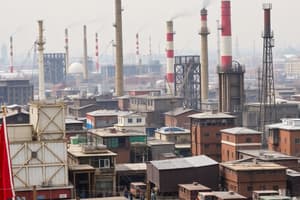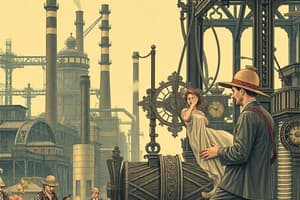Podcast
Questions and Answers
Which of the following was NOT a major factor contributing to the rapid industrialization of the United States during the late 19th century?
Which of the following was NOT a major factor contributing to the rapid industrialization of the United States during the late 19th century?
- Transportation
- Government Regulation (correct)
- Immigration
- Various Inventions
What was a negative impact of industrialization?
What was a negative impact of industrialization?
- Increased demand for labor, leading to higher wages
- Farmers facing hardship due to competition from industrial agriculture (correct)
- Expansion of the railroad system
- Increased production of steel and petroleum
What was a key goal of labor unions during the industrial era?
What was a key goal of labor unions during the industrial era?
- To decrease wages for all workers
- To force businesses to pay their workers less
- To reduce working hours and improve working conditions (correct)
- To ensure all factory owners made large profits
What was the federal government's position on supporting labor unions during the industrial era?
What was the federal government's position on supporting labor unions during the industrial era?
Which of the following describes industrialists such as John D. Rockefeller and Andrew Carnegie?
Which of the following describes industrialists such as John D. Rockefeller and Andrew Carnegie?
Which of these was a 'push' factor for immigrants in the US in the late 1800s and early 1900s?
Which of these was a 'push' factor for immigrants in the US in the late 1800s and early 1900s?
Which of the following is a characteristic of 'new' immigrants, compared to 'old' immigrants?
Which of the following is a characteristic of 'new' immigrants, compared to 'old' immigrants?
What is nativism?
What is nativism?
Flashcards
Industrialization in the US
Industrialization in the US
The rapid increase in the production of goods using new technologies and factories during the late 1800s and early 1900s in the United States.
Laissez-faire
Laissez-faire
A policy where the government does not interfere with the economy, allowing businesses to operate freely without regulation.
Nativism
Nativism
The movement that opposes or limits immigration, often based on fears of immigrants taking jobs, changing culture, or being a burden on society.
Chinese Exclusion Act
Chinese Exclusion Act
Signup and view all the flashcards
Push Factors (Immigration)
Push Factors (Immigration)
Signup and view all the flashcards
Pull Factors (Immigration)
Pull Factors (Immigration)
Signup and view all the flashcards
Urbanization
Urbanization
Signup and view all the flashcards
Working Conditions in the Industrial Era
Working Conditions in the Industrial Era
Signup and view all the flashcards
Study Notes
Industrialization, Immigration, and Urbanization
-
Key factors contributing to rapid US industrialization included immigration, transportation advancements, and various inventions. Economic growth and government support also played a role.
-
Positive effects of industrialization included advancements in transportation and communication technologies, economic growth, and increased employment opportunities.
-
Negative effects included harsh working conditions, low wages, overpopulation, disease spread, and crime.
Labor Unions
-
Labor unions sought better wages, shorter working hours, and improved working conditions.
-
During this time period, the federal government generally did not support labor union efforts.
-
Industrialists like Rockefeller and Carnegie were considered robber barons for exploiting workers and maximizing profits, but were also seen as captains of industry due to expanding jobs and increasing wealth.
Immigration
-
Push factors for immigration included poverty, lack of land, religious persecution, and political unrest.
-
Pull factors for immigration included opportunities in factories, better wages, and education.
-
"Old" immigrants were wealthier, more educated, and from Western Europe.
-
"New" immigrants were poorer, less educated, and from Eastern and Southern Europe.
-
Large numbers of immigrants contributed to urbanization and workforce growth.
Nativism
-
Nativism is the policy of favoring native-born citizens over immigrants.
-
The Chinese Exclusion Act is an example of nativism. It banned Chinese laborers from immigrating to the US.
Urbanization
-
Industrialization led to a dramatic increase in people living in cities.
-
Problems in urban areas included overcrowding, crime, poor sanitation, disease spread, and lack of resources.
Child Labor
-
Child labor was permitted.
-
Children worked in factories, mines, and other industries due to financial necessity and lack of regulations.
Studying That Suits You
Use AI to generate personalized quizzes and flashcards to suit your learning preferences.





